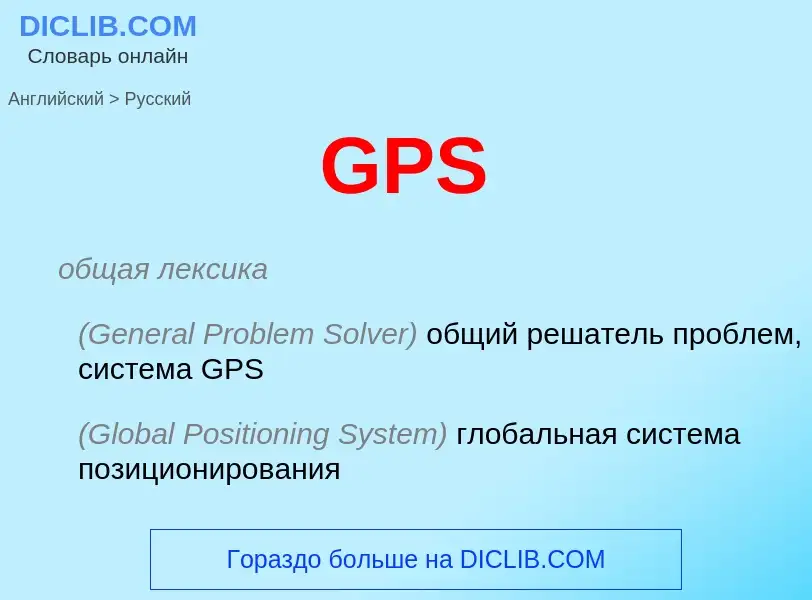Translation and analysis of words by ChatGPT artificial intelligence
On this page you can get a detailed analysis of a word or phrase, produced by the best artificial intelligence technology to date:
- how the word is used
- frequency of use
- it is used more often in oral or written speech
- word translation options
- usage examples (several phrases with translation)
- etymology
GPS - translation to English
общая лексика
(General Problem Solver) общий решатель проблем, система GPS
(Global Positioning System) глобальная система позиционирования
сокращение
[gallons per second] (число) галлонов в секунду
Смотрите также
существительное
общая лексика
глобальная система навигации и определения положения
синоним
общая лексика
GPS
система глобального позиционирования (через спутниковые ретрансляторы) СГП
спутниковая система позиционирования, позволяющая с помощью специального приёмника осуществить быстрое автоматическое определение координат в любой точке мира (точность колеблется от 10 до 100 м) и скорости перемещения различных объектов на поверхности Земли и в воздушном пространстве. Состоит из 24 спутников, принадлежащих правительству США. Использует частоту 1575,42 МГц для гражданских целей и 1227,6 МГц - для военных. Спутники группировки GPS передают также сигналы точного времени, основанные на собственных бортовых атомных часах. Приёмники GPS производятся в виде навигационных систем для автомобилей, а также модулей, устанавливаемых в карманные ПК и сотовые телефоны
Смотрите также
Wikipedia

The Global Positioning System (GPS), originally Navstar GPS, is a satellite-based radionavigation system owned by the United States government and operated by the United States Space Force. It is one of the global navigation satellite systems (GNSS) that provides geolocation and time information to a GPS receiver anywhere on or near the Earth where there is an unobstructed line of sight to four or more GPS satellites. It does not require the user to transmit any data, and operates independently of any telephonic or Internet reception, though these technologies can enhance the usefulness of the GPS positioning information. It provides critical positioning capabilities to military, civil, and commercial users around the world. Although the United States government created, controls and maintains the GPS system, it is freely accessible to anyone with a GPS receiver.
The GPS project was started by the U.S. Department of Defense in 1973. The first prototype spacecraft was launched in 1978 and the full constellation of 24 satellites became operational in 1993. Originally limited to use by the United States military, civilian use was allowed from the 1980s following an executive order from President Ronald Reagan after the Korean Air Lines Flight 007 disaster. Advances in technology and new demands on the existing system have now led to efforts to modernize the GPS and implement the next generation of GPS Block IIIA satellites and Next Generation Operational Control System (OCX). which was authorized by the U.S. Congress in 2000.
From the early 1990s, GPS positional accuracy was degraded by the United States government by a program called Selective Availability, which could selectively degrade or deny access to the system at any time, as happened to the Indian military in 1999 during the Kargil War. However, this practice was discontinued on May 1, 2000, in accordance with a bill signed into law by President Bill Clinton. As a result, several countries have developed or are in the process of setting up other global or regional satellite navigation systems.
The Russian Global Navigation Satellite System (GLONASS) was developed contemporaneously with GPS, but suffered from incomplete coverage of the globe until the mid-2000s. GLONASS reception in addition to GPS can be combined in a receiver thereby allowing for additional satellites available to enable faster position fixes and improved accuracy, to within two meters (6.6 ft).
China's BeiDou Navigation Satellite System began global services in 2018, and finished its full deployment in 2020. There are also the European Union Galileo navigation satellite system, and India's NavIC. Japan's Quasi-Zenith Satellite System (QZSS) is a GPS satellite-based augmentation system to enhance GPS's accuracy in Asia-Oceania, with satellite navigation independent of GPS scheduled for 2023.
When selective availability was lifted in 2000, GPS had about a five-meter (16 ft) accuracy. GPS receivers that use the L5 band have much higher accuracy, pinpointing to within 30 centimeters (11.8 in), while high-end users (typically engineering and land surveying applications) are able to have accuracy on several of the bandwidth signals to within two centimeters, and even sub-millimeter accuracy for long-term measurements. Consumer devices, like smartphones, can be as accurate as to within 4.9 m (or better with assistive services like Wi-Fi positioning also enabled). As of May 2021, 16 GPS satellites are broadcasting L5 signals, and the signals are considered pre-operational, scheduled to reach 24 satellites by approximately 2027.



![Emblem of the [[50th Space Wing]] Emblem of the [[50th Space Wing]]](https://commons.wikimedia.org/wiki/Special:FilePath/50th Space Wing.png?width=200)





![Ground monitor station used from 1984 to 2007, on display at the [[Air Force Space and Missile Museum]] Ground monitor station used from 1984 to 2007, on display at the [[Air Force Space and Missile Museum]]](https://commons.wikimedia.org/wiki/Special:FilePath/GPS monitor station.jpg?width=200)
![antenna]] is mounted on the roof of a hut containing a scientific experiment needing precise timing. antenna]] is mounted on the roof of a hut containing a scientific experiment needing precise timing.](https://commons.wikimedia.org/wiki/Special:FilePath/GPS roof antenna dsc06160.jpg?width=200)
![Unlaunched GPS block II-A satellite on display at the [[San Diego Air & Space Museum]] Unlaunched GPS block II-A satellite on display at the [[San Diego Air & Space Museum]]](https://commons.wikimedia.org/wiki/Special:FilePath/Global Positioning System satellite.jpg?width=200)

![Attaching a GPS guidance kit to a [[dumb bomb]], March 2003 Attaching a GPS guidance kit to a [[dumb bomb]], March 2003](https://commons.wikimedia.org/wiki/Special:FilePath/US Navy 030319-N-4142G-020 Ordnance handlers assemble Joint Direct Attack Munition (JDAM) bombs in the forward mess decks.jpg?width=200)
![[[M982 Excalibur]] GPS-guided [[artillery shell]] [[M982 Excalibur]] GPS-guided [[artillery shell]]](https://commons.wikimedia.org/wiki/Special:FilePath/XM982 Excalibur inert.jpg?width=200)
